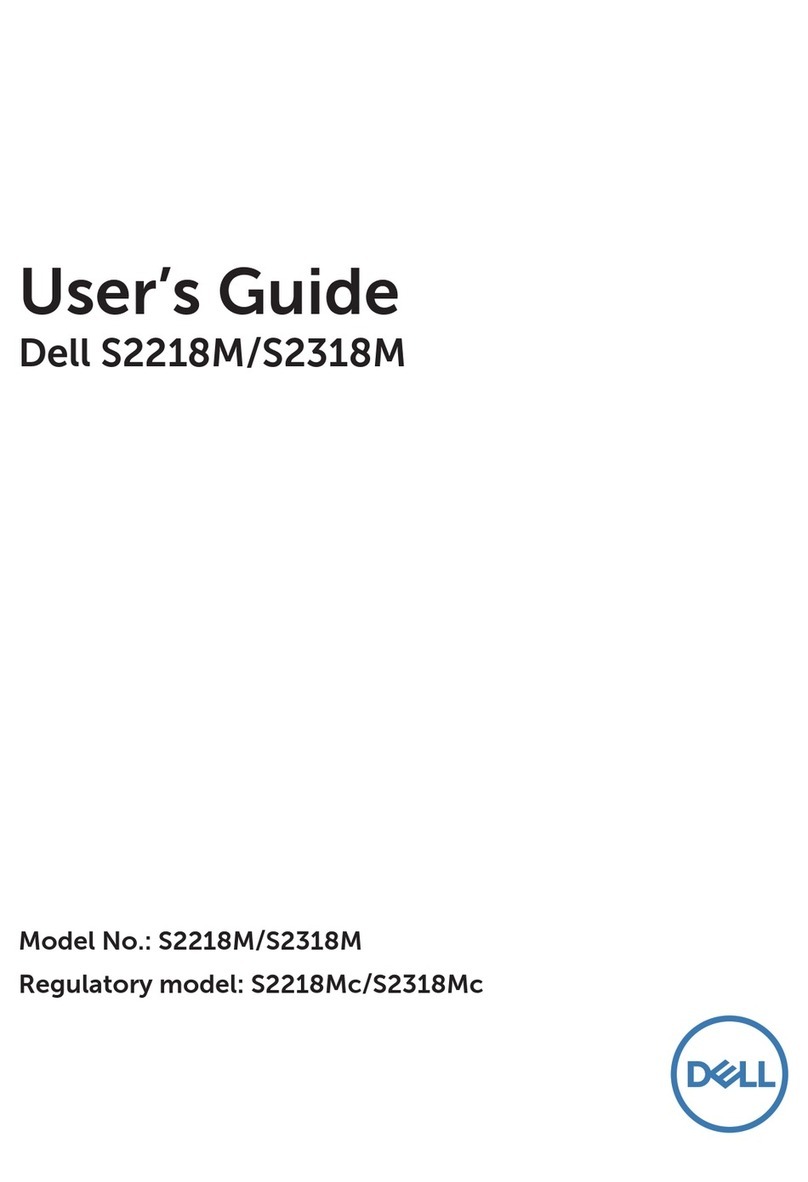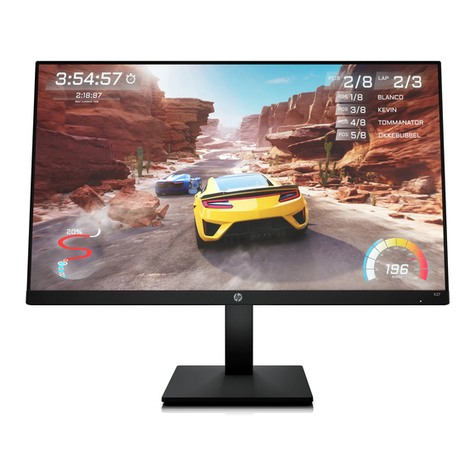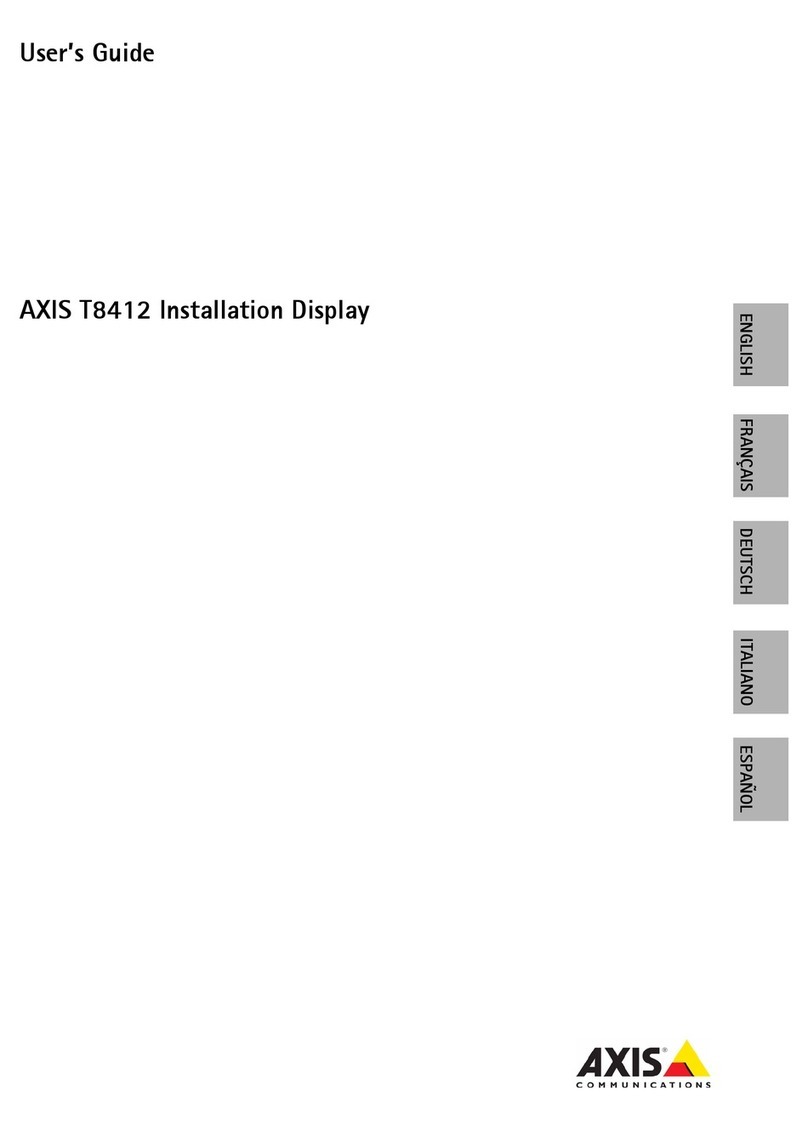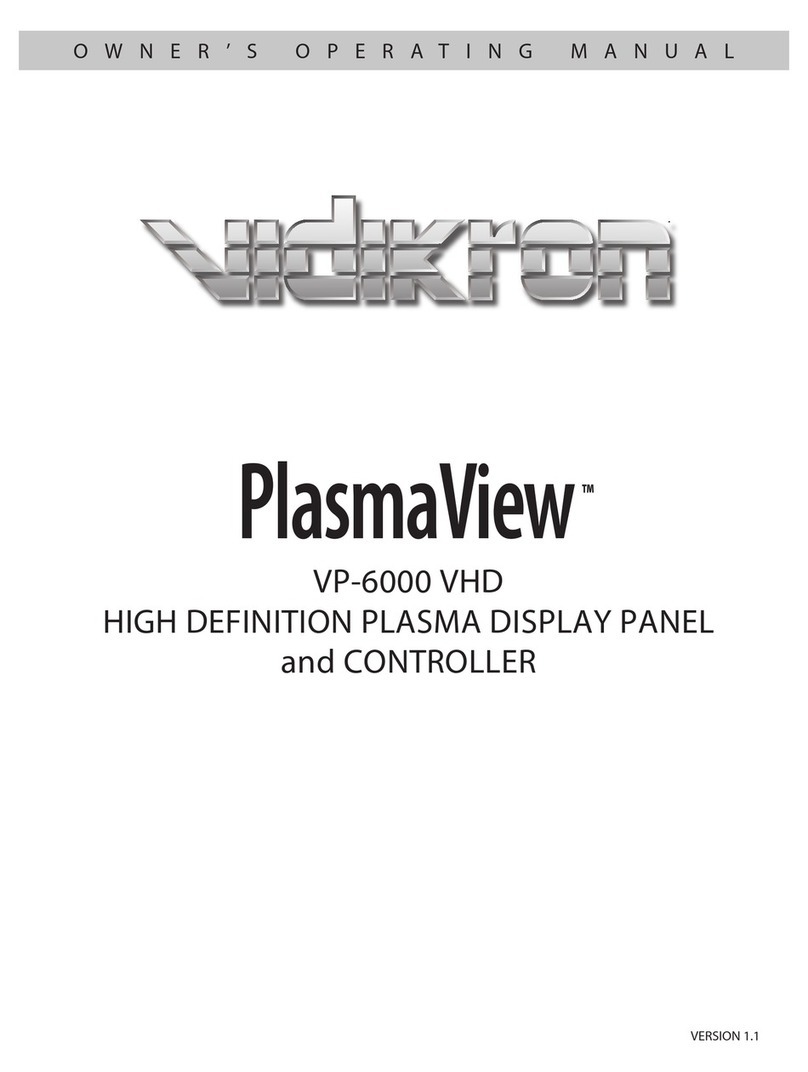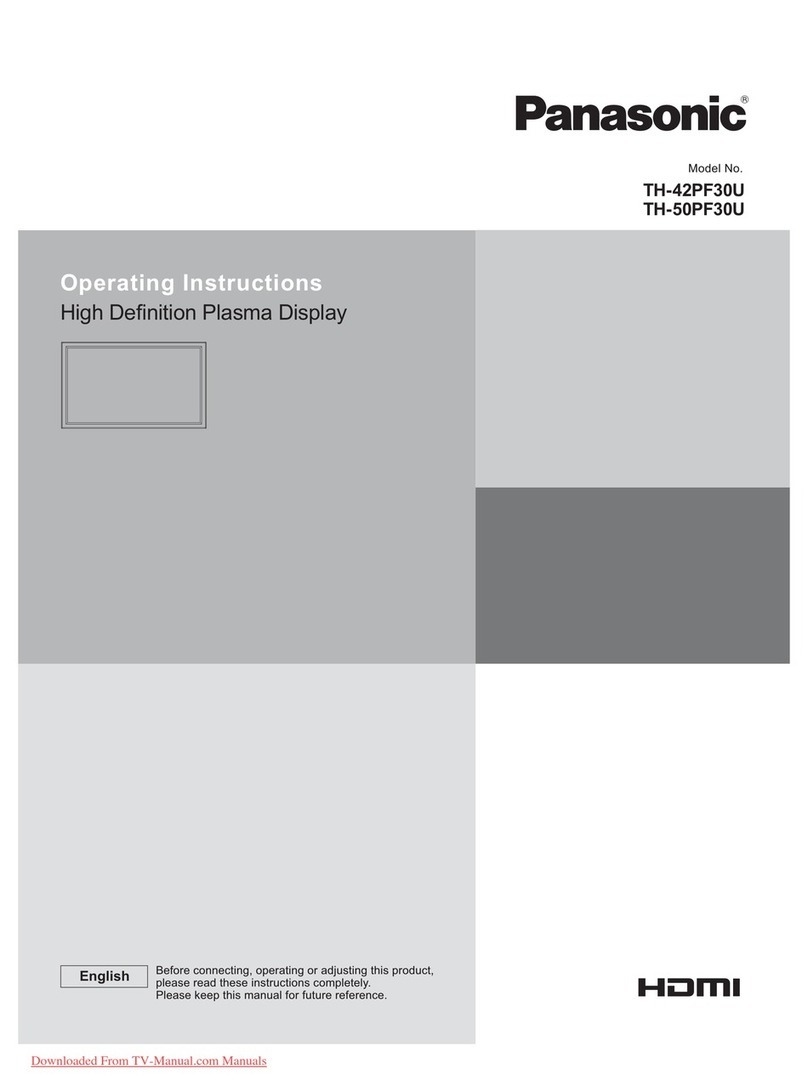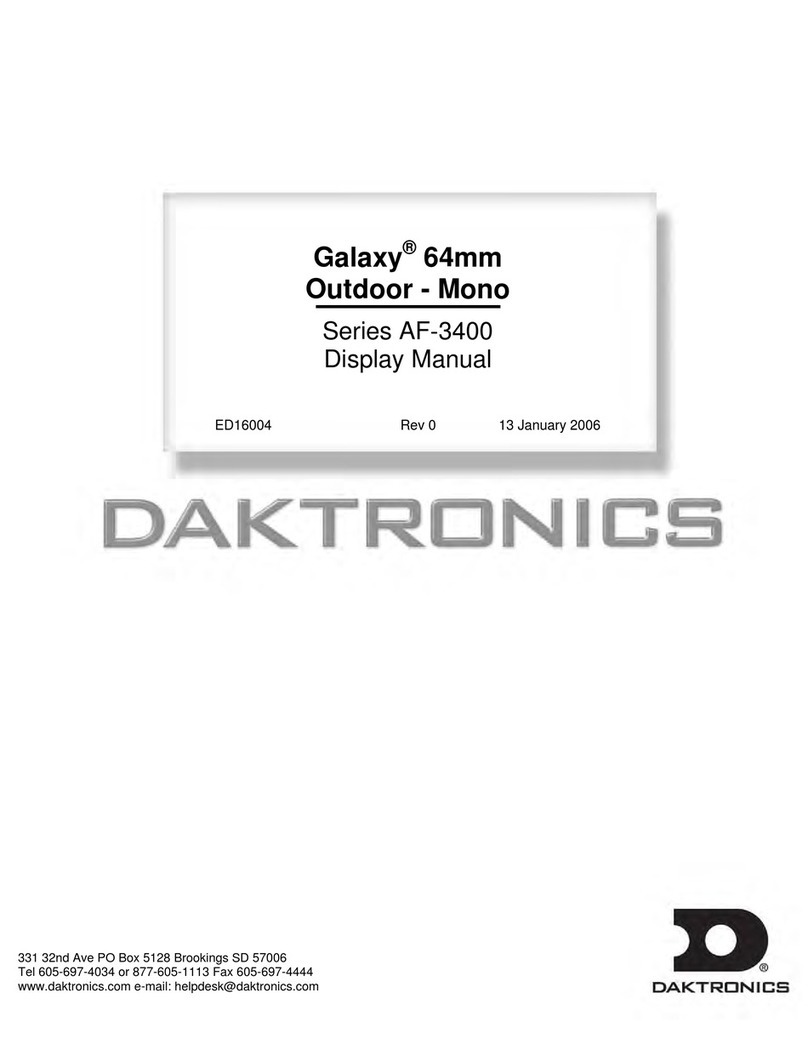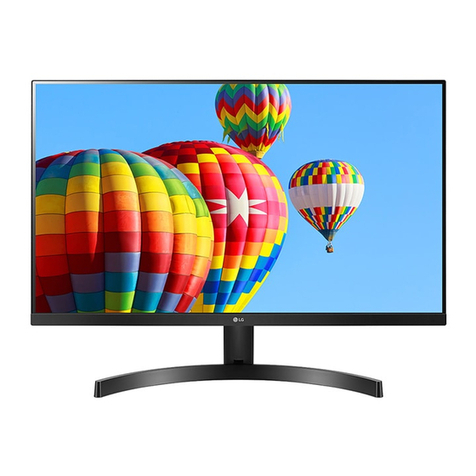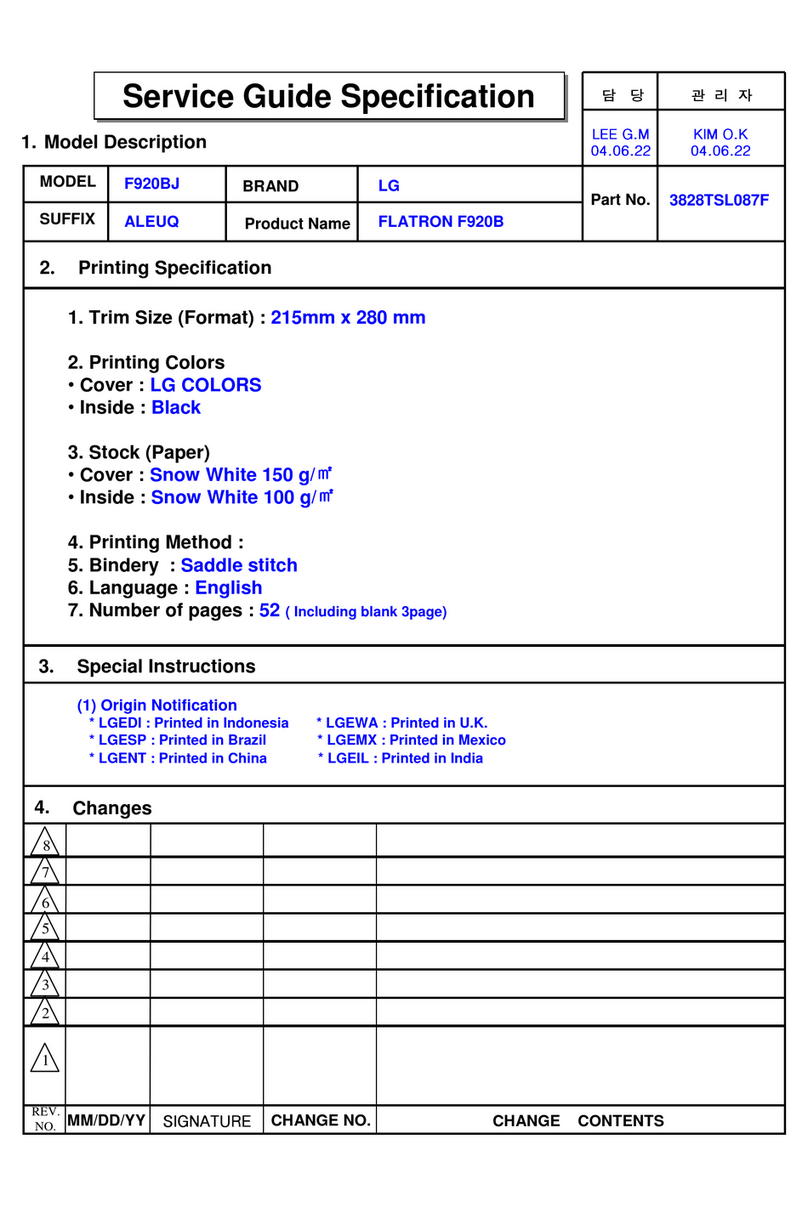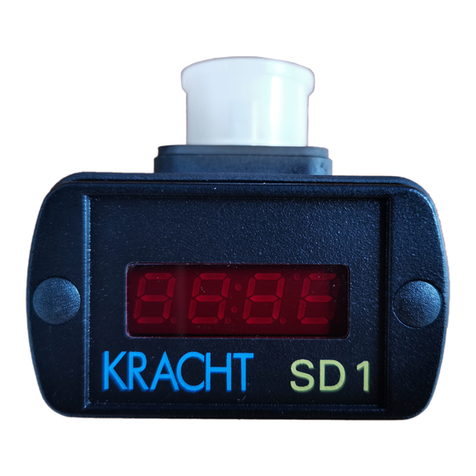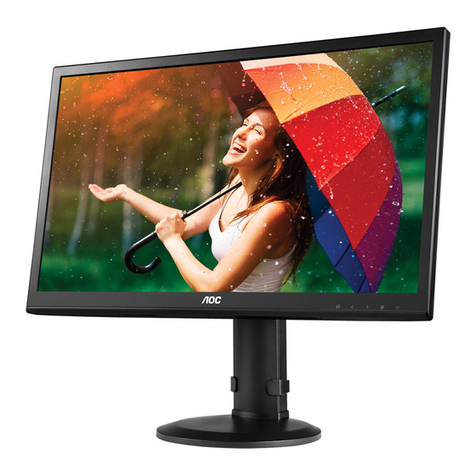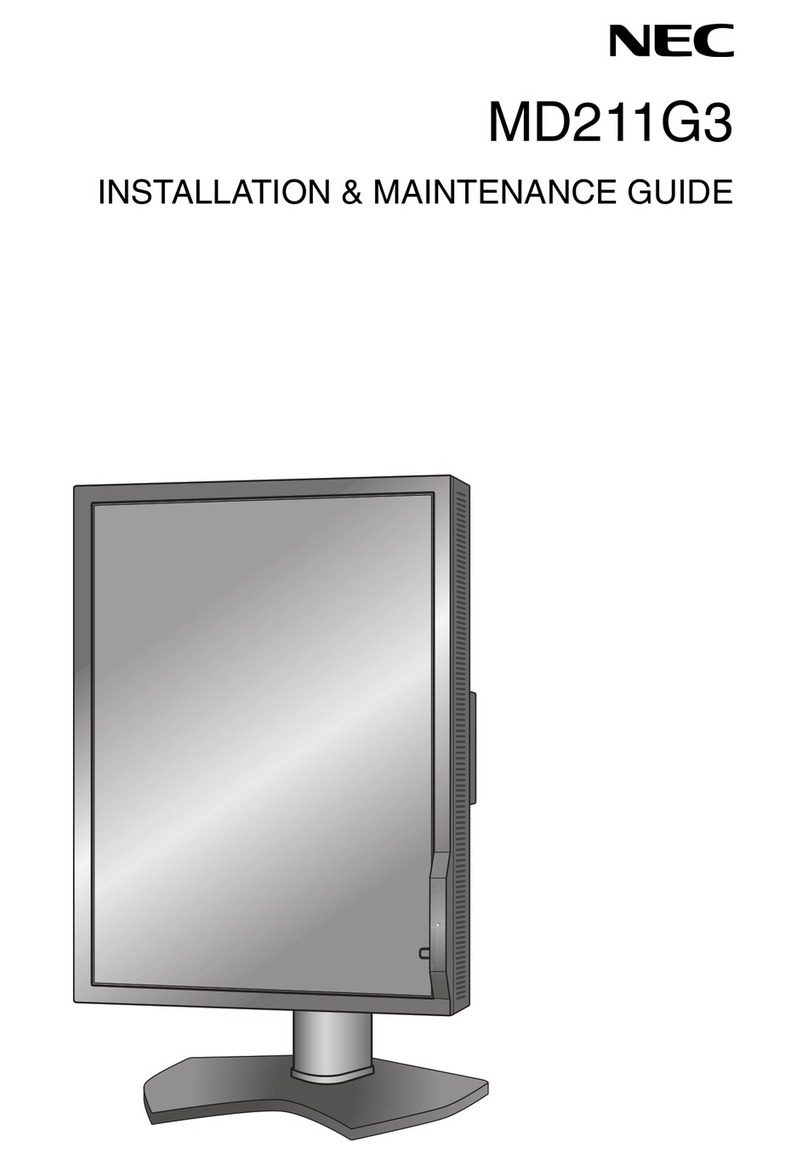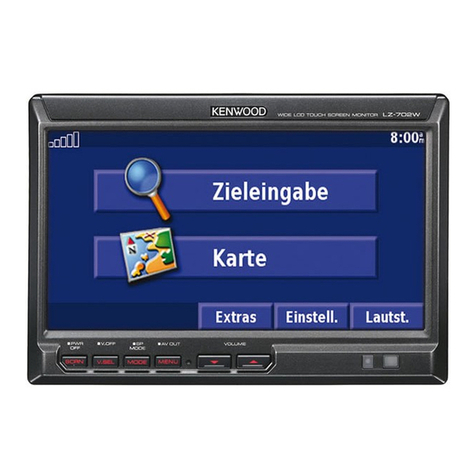Encision EM3 AEM User manual

04642-003
User’s Guide
EM3 AEM® Monitor

Manufactured By:
Encision Inc.
6797 Winchester Circle
Boulder, Colorado, USA, 80301-3513
Made in Bulgaria
Ph: 800-998-0986
Fax: 303-444-2693
www.encision.com
Authorized Representative:
(according to MDD93/42/EEC)
MDSS GmbH
Schiffgraben 41
30175 Hannover, Germany
US Patents
# 5,312,401 and 5,688,269.
International Patents
Japan Patent # 2,509,081
Canada Patent # 2,112,817
European Patent Convention # 0596909
Australia Patent # 667322
Trademark acknowledgments
Encision®and AEM® are registered trademarks of Encision Inc.
All other referenced trademarks are owned by their respective owners.
Printed in USA
Part Number: 04642-003 Rev. F2018/04
© 2018 Encision Inc. All rights reserved.
EM3

EM3 AEM Monitor User’s Guide
Table of Contents
Foreword
Indications for Use ....................................................................................i
Contraindications ......................................................................................i
Conventions Used in This Manual.............................................................i
Warnings and Cautions............................................................................ii
Explosion, Fire, and Shock Hazards....................................................ii
General Electrosurgical Hazards......................................................... iii
Active Accessories and AEM Monitor......................................................iv
Electromagnetic Compatibility (EMC) Hazards.........................................v
Symbol Definitions ...................................................................................v
A Accessories ................................................................................A-1
1 Introduction
Unpacking the AEM Monitoring System ................................................1-1
Active Electrode Monitoring...................................................................1-2
Monopolar Electrosurgery .....................................................................1-2
Bipolar Electrosurgery...........................................................................1-2
2 Controls, Indicators, and Receptacles
Covers ..................................................................................................2-1
Front Panel ...........................................................................................2-2
Rear Panel............................................................................................2-4
3 System Setup
Setup for Monopolar Applications..........................................................3-1
Maximum Power Settings for Electrosurgical Generators......................3-4
Instrument Functional Test (Monopolar)................................................3-4
Setup for End Point Monitoring System (Bipolar Applications)...............3-5
End Point Monitoring System Check.....................................................3-7
4 System Maintenance and Troubleshooting
System Maintenance.............................................................................4-1
Monopolar System Check.................................................................4-1
Electrical Inspection of the End Point Monitoring Display..................4-3
Mechanical Inspection......................................................................4-3
Cleaning the AEM Monitor ....................................................................4-3
Storing the AEM Monitor.......................................................................4-3
Troubleshooting – AEM Monitor (Monopolar)........................................4-4
Troubleshooting – Bipolar Current Indicator (Bipolar)............................4-6
5 Principles of Operation
Theory of Operation – AEM Monitoring System (Monopolar).................5-1
Theory of Operation - End Point Monitoring System (Bipolar) ...............5-3

Table of Contents
EM3 AEM Monitor User’s Guide
6 Surgical Use
Before Surgery......................................................................................6-1
Monopolar Surgery ...............................................................................6-1
Bipolar Surgery.....................................................................................6-2
General Precautions.............................................................................6-2
Return Electrode...............................................................................6-2
Active Accessories ...........................................................................6-2
Operating Room Troubleshooting.........................................................6-3
Correcting Setup Faults....................................................................6-3
Responding to Monitor Alarms..........................................................6-3
Preparing the AEM Monitor for Reuse...................................................6-4
7 Technical Specifications
Operating Modes - AEM Monitoring......................................................7-1
Functional Characteristics.....................................................................7-1
Indicators and Alert Functions...............................................................7-2
Setup Fault Indicators ......................................................................7-2
Operative Fault Indicators ................................................................7-2
Status Indicators ..............................................................................7-2
Bipolar Current Indicator...................................................................7-2
Connectors and Cables.........................................................................7-3
Maximum Generator Voltage ................................................................7-4
Electrical Characteristics.......................................................................7-4
Dimensions and Weight........................................................................7-4
Environmental Characteristics...............................................................7-4
Standards and IEC Classifications........................................................7-4
Compatible Products.............................................................................7-8
Electrosurgical Generators...............................................................7-8
Return Electrodes.............................................................................7-8
Active Electrodes..............................................................................7-8
8 Replacement Parts and Service
Replacement Parts and Procedures......................................................8-1
Customer Replaceable Parts............................................................8-1
Replacing the Fuse ..........................................................................8-1
Returning the AEM Monitor...................................................................8-1
Obtaining a Return Material Authorization Number...........................8-1
Cleaning the Monitor ........................................................................8-2
Shipping the Monitor ........................................................................8-2
Service Center .................................................................................8-2
Limited Warranty...................................................................................8-3
Service Center
Encision Inc.
6797 Winchester Circle
Boulder, Colorado 80301-3513 USA
(800) 998-0986
www.encision.com

EM3 AEM Monitor User’s Guide i
Foreword
This manual and the equipment it describes are for use only by qualified medical professionals
trained in the particular technique and surgical procedure to be performed. This manual is
intended as a guide for servicing the AEM Monitor, including its setup and operation. It is not
intended to be a general reference about the use of electrosurgery either in general application
or in laparoscopic procedures.
Indications for Use
The Encision AEM Monitoring System is an accessory for use with electrosurgical generators
and electrodes that is designed to safely deliver electrosurgical energy and to prevent injury
caused by insulation failure and capacitive coupling.
The AEM Monitoring System consists of two distinct functions:
Active electrode monitoring is intended to control stray monopolar energy caused by
insulation failure and capacitive coupling in surgical instruments on the shaft of the
instrument.
End point monitoring is intended to aid the surgeon in determining the end point of bipolar
electrosurgical desiccation.
Contraindications
There are no known contraindications for use of the AEM Monitor.
WARNING
Prior to using the AEM System, read and review all instructions in this manual and instructions for use
for all instruments and accessories to be used.
CAUTION
Federal (USA) law restricts this device to sale by or on the order of a physician.
The AEM Monitor is designed to safely deliver electrosurgical energy and to prevent injury caused by
insulation failure and capacitive coupling. The Encision AEM Monitor is not intended to test for insulation
damage on laparoscopic instruments. Do not attempt to use this system as an instrument inspection tool.
Conventions Used in this Manual
WARNING
Indicates a hazardous condition that can result in serious injury or death.
CAUTION
Indicates a condition that can cause a problem with the device.
NOTICE
Indicates an operating tip or maintenance suggestion.

Foreword
ii EM3 AEM Monitor User’s Guide
Warnings and Cautions
Refer to the manual of your electrosurgical generator (ESU) for applications information
including warnings and precautions regarding its use before proceeding further.
Explosion, Fire, and Shock Hazards
WARNING
Explosion Hazard. Do not use electrosurgery in the presence of flammable anesthetics.
Fire/Explosion Hazard. The following substances will contribute to increased fire and explosion
hazards in the operating room:
Flammable substances (such as alcohol based skin prepping agents and tinctures).
Naturally occurring flammable gases which may accumulate in body cavities such as the bowel.
Oxygen agents (such as nitrous oxide [N2O] atmospheres).
The sparking and heating associated with electrosurgery can provide an ignition source. Observe fire
precautions at all times. When using electrosurgery in the same room with any of these substances or
gases, prevent their accumulation or pooling under surgical drapes, or within the area where
electrosurgery is performed.
Fire Hazard. Do not use extension cords.
Fire Hazard. For continued protection against fire hazard replace fuses only with the same type and
rating.
Fire Hazard. Electrosurgical accessories that are activated or hot from use can cause a fire. Do not
place them near or touching flammable materials (such as gauze or surgical drapes).
Electric Shock Hazard. Connect the monitor power cord to a properly grounded receptacle. Do not use
power strip plug adapters.
Electric Shock Hazard. Ensure that all accessories, cords, and adapters are correctly connected and
that no metal is exposed.
Electric Shock Hazard. Do not connect a wet power cord to the AEM Monitor or to the wall receptacle.
Electric Shock Hazard. Always unplug the AEM Monitor before cleaning.
Electric Shock Hazard. Do not open the AEM Monitor cover.

Foreword
EM3 AEM Monitor User’s Guide iii
General Electrosurgical Hazards
WARNING
Any electrosurgical procedure is safest if moderate control settings are used along with minimum
activation times. Prolonged activations without the electrode in contact with the tissue should be
avoided.
Confirm proper electrosurgical power setting before proceeding with surgery. Use the lowest power
setting that achieves the desired surgical effect.
In order to lessen the possibility of creating unintended burns, activate the electrosurgical generator
only when the active electrode is near or touching the target tissue.
The safe use of monopolar electrosurgery requires proper placement of the patient return electrode.
To avoid electrosurgical burns beneath the patient return electrode, follow all directions on the
product package for proper return electrode placement and use.
In some circumstances, potential exists for alternate site burns at points of skin contact (e.g., between
the arm and the side of the body). This occurs when electrosurgical current seeks a path to the
patient return electrode that includes a skin to skin contact point. Current passing through small skin
to skin contact points is concentrated and may cause a burn. This is true for earth referenced and
isolated output generators.
To reduce the potential for alternate site skin burns, do one or more of the following:
Avoid skin to skin contact points, such as fingers touching leg, when positioning the patient.
Place two to three inches of dry gauze between contact points to ensure that contact does not
occur.
Position the patient return electrode to provide a direct current route between the surgical site and
the return electrode which avoids skin-to-skin contact.
In addition, place patient return electrodes according to the manufacturer’s instructions.
Keep electrical connections dry while in use to prevent potential conduction of High Frequency (HF)
current to the user.
Potentially hazardous conditions may exist when accessories of similar connector types are
intermixed. Be certain that accessories are appropriate for the type of electrosurgical generator
output used and the intended application.
While using electrosurgery, the patient should not be allowed to come into direct contact with
grounded metal objects (e.g., surgical table frame, instrument table, etc.). If this is not possible
during certain procedures (e.g., those in which noninsulated head frames are used), use extreme
caution to maximize patient safety:
Use the lowest power setting that achieves the desired effect.
Place the patient return electrode as close to the surgical site as possible.
Place dry gauze between the patient and the grounded object if possible.
Continually monitor the contact point(s).

Foreword
iv EM3 AEM Monitor User’s Guide
Active Accessories and AEM Monitor
WARNING
These devices have been specifically designed for use in electrosurgery. Do not use for other
procedures.
Do not wrap accessory cords around metal objects. Wrapping cords around metal objects may induce
currents that could lead to shocks, fires, or injury.
The electrode tip may remain hot enough to cause burns after the electrosurgical current is
deactivated.
When not in use, place accessories in a clean, dry, nonconductive and highly visible area not touching
the patient. Inadvertent contact with the patient may result in burns.
Inadvertent activation or movement of the activated electrode tip outside the field of vision may result
in injury to the patient. Use these instruments only under conditions that ensure adequate
visualization.
Localized burns to the patient or physician may come from electrical currents carried through
conductive objects (such as cannulas or scopes). Electrical current may be generated in conductive
objects by direct contact with the active accessory cable being in close proximity to the conductive
object.
Ensure that the insulation of conventional, nonshielded disposable and reusable laparoscopic
instrumentation is intact. Compromised insulation of nonshielded instruments may lead to shocks or
burns to the patient or surgical personnel.
When using laparoscopic instrumentation with metal cannulas, the potential exists for abdominal wall
burns to occur in the event of direct electrode tip contact to the cannula.
Refer to the cannula manufacturer’s instructions before inserting the electrode into the cannula. To
avoid damaging the electrode or injuring the patient, insert and withdraw them carefully.
Inspect cords for breaks, cracks, nicks or other damage before every use. Verify that end of life
indicators are not present. If any of these are present, do not use. Failure to observe this precaution
may result in injury or electrical shock to the patient or operating personnel.
Damaged external insulation on instruments AND incorrect setup of the AEM Monitor may result in a
risk of unintended patient burn. Do not use product having damaged insulation.
When an alert is presented by the AEM Monitor, discontinue use of the electrosurgical current
immediately. Find the cause of the alert and correct it before continuing use.
Damaged internal insulation of the instrument, or loss of shield continuity, may cause AEM Monitor
alarms. For maximum patient safety, discontinue use of the instrument if this occurs.
A single AEM instrument must be the sole conductor of energy to tissue. Do not conduct energy by
touching an AEM instrument to a second instrument contacting tissue. The second device will not be
protected from capacitive coupling and insulation failure.
Good operating room practice suggests that connections of accessories to electrosurgical generators
be made only while the generator is off or in standby mode.
Use the AEM Monitor only if the Power On Self Test (POST) has been properly completed (see
Section 3 for details). Otherwise, AEM functions may not be operative.
CAUTION
Read the instructions, warnings, and cautions provided with the AEM Monitoring System accessories before
using. Their specific instructions are not included in this manual.
AEM Monitoring will not function without the use of a dual pad return electrode and an electrosurgical
generator equipped with contact quality monitoring patient safety technology.
Limit power setting to 80 watts or lower as specified in the power settings tables (see Section 3). Higher
settings may result in spurious insulation failure alarms and/or insulation breakdown. Refer to instrument
instructions for use for other limits.

Foreword
EM3 AEM Monitor User’s Guide v
Electromagnetic Compatibility (EMC) Hazards
For EMC specification tables, refer to Section 7, Technical Specifications.
CAUTION
Use of accessories, transducers, and cables other than those specified, with the exception of transducers
and cables sold by the manufacturer of the Equipment or System as replacement parts for internal
components, may result in increased Emissions or decreased Immunity of the Equipment or System.
The AEM Monitor should not be used adjacent to or stacked with other equipment except as specified
herein. If adjacent or stacked use is necessary, the equipment should be observed to verify normal
operation in the configuration in which it will be used.
Follow the electrosurgery unit manufacturer’s instructions as far as locating equipment within the operating
room to diminish or eliminate radio frequency electrical interference with other electronic equipment.
Medical electrical equipment needs special precautions regarding EMC and needs to be installed and put
into service according to the EMC information provided in the accompanying documents. Portable and
mobile RF communications equipment can affect medical electrical equipment.
Symbol Definitions
EM3 Symbol Glossary
Symbol
Meaning
ISO 7000 Ref No.
Symbol
Meaning
ISO 7000 Ref No.
Manufacturer 3082 Consult Instructions for use 1641
Serial Number 2498 Temperature Limits 0632
Date of Manufacture 2497
Humidity Limitation 2620
Catalog Number/Reference 2493 Caution – Read Instructions for use for
further details 0434A
Symbol
Meaning
Reference
Symbol
Meaning
Reference
Refer to Instruction Manual ISO 7010 Ref # M002
Volume Control IEC 60417 Ref# 5535
Defibrillation-proof type CF
applied part
IEC 60417 Ref # 5336
Authorized Representative in the
European Community
ISO 15223, 5.1.2 EN 980,
5.13
Caution, Risk of electric shock IEC 60417 Ref# 6042 Prescription Only 21 CFR Part 801.109
Equipotentiality IEC 60417 Ref# 5021
CE Mark Medical Device Directive,
93/42/EEC,
HF Isolated Patient Circuit
IEC 60601-2-2 Figure
201.102
WEEE Wheeled Bin. This
product is to be disposed of
separately from the municipal
waste stream.
2002/96/EC EN50419
Fuse Rating IEC 60417 Ref# 5016
Graphical Representations
Hand Control Connector Return Electrode Instrument Cord Connection
Fault
Foot Control Connector
Remote Display Jack
Bipolar Accessory

EM3 AEM Monitor User’s Guide A-1
A Accessories
Use the AEM Monitor with the following Encision accessories. Separate Instructions for Use are
provided with the accessories.
EM3 Monopolar Adapter
AEM Cord/Cable
EM3 Bipolar Adapter
Bipolar Instrument Cords
AEM Handle Assembly
Inserts, Reusable and Disposable
Disposable Sheath
Fixed Tip Electrodes, Reusable and Disposable
Suction Irrigation Electrodes, Reusable and Disposable
AC Input Cord, Hospital Grade 120v, 15’ (4.6 m)
Or Encision approved compatible accessories.
CAUTION
Use of other accessories or cables may result in increased EMC emissions or decreased immunity.
Contact Customer Service at 1(800) 998-0986 or (303) 444-2600 for current catalog
or go to www.encision.com.

EM3 AEM Monitor User’s Guide 1-1
1 Introduction
Congratulations on your purchase of the AEM Monitor. Active electrode monitoring
technology continuously monitors and dynamically manages stray current during monopolar
electrosurgery.
CAUTION
The Encision AEM System is designed to safely deliver electrosurgical energy and to prevent injury
caused by insulation failure and capacitive coupling. The AEM system is not intended to test for
insulation damage on laparoscopic instruments. Do not attempt to use this system as an instrument
inspection tool.
The AEM Monitor consists of two distinct functions:
Active Electrode Monitoring –Intended to control stray monopolar energy caused by
insulation failure and capacitive coupling in surgical instruments on the shaft of the
instrument.
End Point Monitoring – Intended to aid the surgeon in determining the end point of
bipolar electrosurgical desiccation.
Unpacking the AEM Monitoring System
The AEM system is shipped in one carton. Store this carton so that it will be available if the
need for service arises.
Carefully unpack the carton. Check to ensure you received the following parts. If any of
these parts are missing, contact Customer Service immediately.
EM3 AEM Monitor
Power Cord
Quick Setup Guide
Contact Encision Customer Service at 1(800) 998-0986 or local customers call (303) 444-
2600 to arrange for repair or replacement of any parts damaged from shipping.

Introduction
1-2 EM3 AEM Monitor User’s Guide
Active Electrode Monitoring
Active electrode monitoring technology can eliminate the risk of stray electrical energy
caused by insulation failure and capacitive coupling and thus helps to prevent unintended
internal burn injury to the patient. AEM instruments direct electrosurgical energy where the
surgeon desires, while continuously monitoring the current flow to prevent stray
electrosurgical energy from insulation failure or capacitive coupling.
AEM instruments have a patented, multi-layered design with a built-in shield, much like the
third wire ground in standard electrical cords. The shield in these instruments is referenced
back to a monitor at the electrosurgical generator. In the event of a harmful level of stray
electrical energy, the monitor shuts down the power; ensuring patient safety. The AEM
system protects against capacitive coupling by providing a neutral return path for capacitively
coupled electrical current. Capacitively coupled energy is continually drained away from the
instrument and away from the patient through the protective shield built into all AEM
instruments.
Monopolar Electrosurgery
In monopolar electrosurgery, the surgical instrument contains only the active electrode. A
separate return electrode attached to the patient recovers the current that passes through the
patient and returns it safely to the electrosurgical generator.
Monopolar electrosurgery is used for most surgical procedures that require sparking to
tissue, such as those in which tissue must be cut or coagulated over wide areas.
Bipolar Electrosurgery
In bipolar electrosurgery, the surgical instrument includes both electrodes. A patient return
electrode is not used. Current flows between the two electrodes and through the tissue
contacted by the instrument, heating that tissue.
In bipolar electrosurgery, control is needed to ensure the correct degree of heating.

EM3 AEM Monitor User’s Guide 2-1
2 Controls, Indicators, and Receptacles
This section describes the AEM Monitor features. For definitions of symbols, refer to Symbol
Definitions in the Foreword Section.
Covers
Monopolar Adapter Receptacle
Connect the Monopolar Adapter to this receptacle and to the
electrosurgical generator (ESU). See Section 3 for system setup.
Cable Channel
Route the Monopolar Adapter cable through this channel to either side
of the monitor (optional).
Tray
When extended, the tray provides a convenient place to store the
Monopolar Adapter when not connected to the ESU. The tray also has
a recess for storing the Quick Setup Guide.
1
2
1
2
2
3
3

Controls, Indicators, and Receptacles
2-2 EM3 AEM Monitor User’s Guide
Front Panel
POST (Power On Self Test) Reset Indicator
Illuminates green when the monitor has successfully completed POST.
Reset Button
Press this button to reset the monitor and initiate the POST function.
Volume Control Buttons
Press these buttons to increase or decrease the volume level for the bipolar clicks
generated by the monitor. The volume can be completely muted.
Bipolar Current Indicator
Indicates the level of current flowing during bipolar instrument activation.
Bipolar Instrument Receptacle
Connect the bipolar instrument to this receptacle.
Bipolar ESU Adapter Receptacle
Connect the Bipolar Adapter to this receptacle and to the electrosurgical generator. See
Section 3 for system setup.
Return Electrode Indicator
Illuminates green when the return electrode is properly connected and ready for use.
Illuminates amber if the return electrode is of the wrong type or is not connected.
Return Electrode Receptacle
Connect the return electrode to this receptacle.
Instrument Cord Connection Fault Indicator (hand control)
Illuminates solid amber until a hand control instrument and cord are connected. If the
instrument cord is disconnected, the indicator illuminates blinking amber for 30 seconds
before returning to a solid amber illumination. See Section 6 for information on correcting
fault conditions.
Hand Control Instrument Indicator
Illuminates solid amber until a cord, hand control instrument, and return electrode are
properly connected.
Illuminates solid green when a hand control instrument and a return electrode are
properly connected and ready for use.
Illuminates blinking green when a hand control instrument is activated.
Illuminates solid amber if a hand control instrument insulation fault or cord connection
fault is detected.
1
2
4
3
5
6
14
15
11
9
10
8
1
2
3
12
13
4
5
6
9
7
10
8
7

Controls, Indicators, and Receptacles
EM3 AEM Monitor User’s Guide 2-3
Instrument Insulation Fault Indicator
The text “Replace Instrument & Cord” illuminates solid amber (for approximately 30
seconds) if an instrument insulation fault is detected for a hand control or foot control
instrument. See Section 6 for information on correcting fault conditions.
Foot Control Instrument Indicator
Illuminates solid amber until a cord, foot control instrument, and return electrode
are properly connected.
Illuminates solid green when a foot control instrument and a return electrode are
properly connected and ready for use.
Illuminates blinking green when a foot control instrument is activated.
Illuminates solid amber if a foot control instrument insulation fault or cord connection
fault is detected.
Instrument Cord Connection Fault Indicator (foot control)
Illuminates solid amber until a foot control instrument and cord are connected. If the
instrument cord is disconnected, the indicator illuminates blinking amber for 30 seconds
before returning to a solid amber illumination. See Section 6 for information on
correcting fault conditions.
Hand Control Instrument Receptacle
Connect the hand control instrument cord to this receptacle.
Foot Control Instrument Receptacle
Connect the foot control instrument cord to this receptacle.
13
12
11
15
14

Controls, Indicators, and Receptacles
2-4 EM3 AEM Monitor User’s Guide
Rear Panel
Remote Display Receptacle
Not Used
Equipotential Pin
Connect an equipotential conductor to this pin as required by country electrical standards
(optional).
Fuse Drawer
The external fuses are located in this drawer. See Section 8 for instructions on replacing
blown fuses.
Power Entry Module
Connect the power cord provided with the AEM Monitor to this receptacle.
Power Switch
Power the AEM Monitor on or off with this switch.
1
2
3
4
5
4
3
2
1
5

EM3 AEM Monitor User’s Guide 3-1
3 System Setup
This section describes how to set up the AEM Monitoring System, turn it on, connect
accessories, and perform system checks.
WARNING
Fire Hazard. Do not use extension cords.
Electric Shock Hazard. Connect the power cord to a properly grounded receptacle. Do not use power
plug adapters.
Electric Shock Hazard. Do not connect wet accessories to the monitor. Ensure that accessories and
adapters are correctly connected and that no metal is exposed.
Electric Shock Hazard. Do not attempt to connect or disconnect any cable during power activation.
Inspect accessories and cords for breaks, cracks, nicks or other damage before every use. Verify that
end of life indicators are not present. If any of these are present, do not use. Failure to observe this
precaution may result in injury or electrical shock to the patient or operating personnel.
NOTICE
If you are familiar with the EM3 AEM Monitoring System, refer to the Quick Setup Guide for system
connections and troubleshooting in the operating suite. The Quick Setup Guide can be stored in the
Tray located at the front of the Monitor.
Setup for Monopolar Applications
1. Connect the power cord supplied with the AEM Monitor to the power entry module on the
rear panel. Ensure that the power cord is fully seated into the module.
2. Connect the Monopolar Adapter to the AEM Monitor using the receptacle on the top of
the monitor. Route the adapter cable to either side of the monitor using the cable
channel (optional).
3. Place the AEM Monitor on a cart or attach it to a boom system.
4. Place the electrosurgical generator (ESU) on top of the monitor or in close proximity to
the monitor to allow for connection of the Monopolar Adapter.
5. Connect the Monopolar Adapter to your ESU. The adapter plugs into the return
electrode receptacle and a hand control accessory receptacle of the ESU. After properly
connecting the adapter, a secondary hand control accessory receptacle on the ESU may
be accessible for use.
WARNING
Electrosurgical generators shown in this section have been tested for use with the EM3 AEM Monitor.
Use of an untested ESU may result in an inoperative active electrode monitoring system. See Section
7 for a complete list of compatible ESUs.

System Setup
3-2 EM3 AEM Monitor User’s Guide
6. Connect an equipotential conductor to the pin on the monitor rear panel (as required by
country electrical standards).
7. Connect the monitor power cord to a wall receptacle with the proper voltage.
CAUTION
Connect the power cord to a wall outlet having the correct voltage. Otherwise product damage may
result.
Self-Check (Power On Self Test – POST)
8. Turn on the AEM Monitor. The system completes an automatic self-check (POST).
Encision recommends that this self-check be run before beginning each surgical

System Setup
EM3 AEM Monitor User’s Guide 3-3
procedure. If the monitor power is left on between procedures, press the Reset button to
initiate the POST function. During POST, all of the visual indicators illuminate and two
beeps are heard. If this is not the case, see Section 4 System Maintenance and
Troubleshooting.
WARNING
Do not use the AEM Monitor unless the system properly completes the automatic self-check.
Otherwise, AEM functions may not be operative.
Monopolar Accessory Connections to the AEM Monitor
9. Connect the return electrode to the receptacle on the AEM Monitor.
CAUTION
When using the Universal Monopolar Adapter (EM3-60), ensure that the return electrode is connected
to the AEM Monitor and not to the electrosurgical generator. Incorrect connection of the return
electrode results in an improper setup condition and the Return Electrode indicator illuminates amber.
10. Verify that the Return Electrode indicator on the AEM Monitor illuminates green. If the
indicator continues to illuminate amber, see Responding to Monitor Alarms in Section 6.
11. Connect the AEM instrument to the monitor. When using a foot controlled instrument,
connect the AEM Cord with the AEM instrument to the Foot Control Instrument
receptacle. When using a hand controlled instrument, connect the instrument cord to the
Hand Control Instrument receptacle.
12. Verify that the appropriate Instrument indicator illuminates green.If the indicator
illuminates amber after connecting the instrument, see Responding to Monitor Alarms in
Section 6.
CAUTION
If an Instrument indicator illuminates green when an instrument is not connected, see Troubleshooting
in Section 4.
13. Turn on the electrosurgical generator, enabling its contact quality monitoring system. It
should be in its normal operating state.
WARNING
Confirm proper power settings before proceeding with surgery. Use the lowest power setting possible
for the minimum time necessary to achieve the desired surgical effect.
CAUTION
Limit power setting to 80 watts or lower as specified in the following power settings tables. Higher
settings may result in spurious insulation failure alarms and/or insulation breakdown. Refer to
instrument instructions for use for other limits.
14. After successful completion of these steps, the AEM Monitor is ready for use. Encision
recommends that a Monopolar System Check be performed before first surgical use.
See System Maintenance in Section 4.

System Setup
3-4 EM3 AEM Monitor User’s Guide
Maximum Power Settings for Electrosurgical Generators
Refer to the following tables for maximum power settings of electrosurgical generators used
with the EM3 AEM Monitoring System.
Maximum Power Settings for Force FX ESU
(W) Maximum Power Settings for System 5000
ESU (W)
Mode Foot Control
Instrument
Hand
Control
Instrument
Mode
Foot
Control
Instrument
Hand
Control
Instrument
Low Cut
80
80
All Modes
80
80
Pure Cut
80
80
Blend Cut
80
80
Maximum Power Settings for
Low Coag
80
80
Olympus ESG 400 ESU (W)
Med Coag 80 45 Mode
Foot
Control
Instrument
Hand
Control
Instrument
High Coag
80
80
All Modes
80
80
Maximum Power Settings for Force Triad
ESU (W)
Maximum Power Settings for
Covidien FT10 ESU (W)
Mode Foot Control
Instrument
Hand
Control
Instrument
Mode
Foot
Control
Instrument
Hand
Control
Instrument
Pure Cut
80
80
Pure Cut
80
70
Blend Cut
80
80
Fulgurate Coag
80
60
Fulgurate Coag
80
70
Spray Coag
80
65
Spray Coag
80
70
All Remaining Modes
80
80
Instrument Functional Test (Monopolar)
This optional test, performed before surgery begins, verifies proper function and integrity of
instruments. The test verifies that the AEM instrument’s internal insulation is in good
condition and can be expected to perform without fault conditions during surgery.
1. Apply the return electrode to the patient.
2. Set the electrosurgical generator to “coag spray” or “coag fulgurate” (the highest voltage
mode depending upon the generator) and set the power level to the maximum power per
the previous tables.
3. Next, in the sterile field:
Connect the instrument to the AEM Monitoring System following the setup instructions in this
section.
WARNING
Ensure that the instrument tip does not touch any other object.
Activate the instrument using the foot switch or hand control for approximately 3
seconds.
Verify that the power indicator on the generator illuminates and that there are no AEM
Monitor alarms.
Repeat this test on each AEM instrument.
4. Change the ESU power setting to the desired level.
Table of contents

